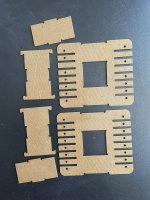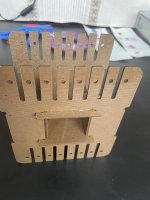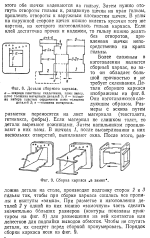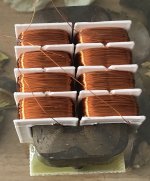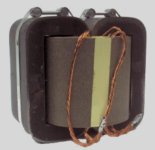I find designing and winding transformers as a unique job, in a sense that it requires a specific mindset. Depending on the severity of requirements on your design, you will need a lot of dedication into practice, reading, experimenting, trial and error. Audio transformer design requires your attention to be very watchful on important details and are less tolerant to errors. Building one needs a considerable amount of concentration and dedication.
In the beginning, one can also face many practical problems, for example figuring out the best equipment for your machine and building the right custom tools for your job.

If you are also a winder, how do you find this type of work for you? Is winding transformer a challenging job for you? Why? What difficulties did you mostly face? What were your biggest winding mistakes?
In the beginning, one can also face many practical problems, for example figuring out the best equipment for your machine and building the right custom tools for your job.
If you are also a winder, how do you find this type of work for you? Is winding transformer a challenging job for you? Why? What difficulties did you mostly face? What were your biggest winding mistakes?
Winding transformers is one of the most nightmare-like aspects of this hobby if you ask me. Through the years I have made some decent output transformers, chokes and power transformers and a long line of failed attempts. I have a homemade Arduino-controlled winding machine but I must admit I often get better results winding manually with a simple crank coupled to a mechanical counter. As long as the wire diameter is somewhere between 0,3 and 0,7mm it's quite easy, thinner wires are hellish to wind in neat layers and thicker wires come with their own set of challenges.
I can relate with your experience on the 0.3-0.7mm sweet spot of winding. Sweet spot for me lies between 0.2 and 0.8mm. I've been able to optimize the machine to 0.15mm dense winding with no crossovers, relying on lossy friction final tensioner (no wire springback).
Down to 0,2mm or so works, I've tried 0,15 too with some success but I don't trust my machine completely with such thin wires. It would need a better wire tension mechanism, I had some ideas about how to do it but now it's been in storage for years. Would be nice to bring it back to life and wind something again, I have some nice old C-cores that probably would make fine OPTs.
Winding transformers is nightmarish indeed. I sometimes resort to doing it, when I have no other choice, but if I have a way of recycling something, anything, that's the way I chose.
I have assembled a crappy winding machine, with an electronic counter, but it is haphazard and doesn't work well.
When I really need to make a good clean job, I still use hand-winding, with a cyanoacrylate glue tube at hand, as well as surgical clamps and pre-prepared mylar insulating sheets; and a sheet of paper and pencil to record the number of turns/layers.
A real PITA, and if I am interrupted, by a phone call or anything else, the whole work is generally wasted; when I was younger, this kind of event was not that catastrophic, but nowadays, anything can derail the process, which is why I try to find a ready made starting-point, especially when large turn numbers are involved.
I have assembled a crappy winding machine, with an electronic counter, but it is haphazard and doesn't work well.
When I really need to make a good clean job, I still use hand-winding, with a cyanoacrylate glue tube at hand, as well as surgical clamps and pre-prepared mylar insulating sheets; and a sheet of paper and pencil to record the number of turns/layers.
A real PITA, and if I am interrupted, by a phone call or anything else, the whole work is generally wasted; when I was younger, this kind of event was not that catastrophic, but nowadays, anything can derail the process, which is why I try to find a ready made starting-point, especially when large turn numbers are involved.
The process of actually winding the transformer in neat layers with the correct number of turns is only one of several parts that can be problematic. Finding the necessary materials is another, and also making safe and secure connections between the windings and whatever the transformer will be connected to.
I would love to find a place that sells metric-sized EI bobbins with solder tags.
I would love to find a place that sells metric-sized EI bobbins with solder tags.
winding coils for transformer is some sort of therapy for me, ideas sometimes trickle in....
You can make them yourself from any suitable sheet material or 3d print. Visual instruction and example attached.I would love to find a place that sells metric-sized EI bobbins with solder tags.
Attachments
Yes, I've made custom bobbins out of PCB laminates (with the copper removed) but it's not easy to get good results with manual tools. I've been thinking about 3D printing bobbins but I'm not sure they would be durable enough.
Interesting. I guess 3D prints can work as long as they are used for thinner wires that doesn't put too much stress on them while winding.
Buy a CNC machine, buy $3 bobbins with $30 shipping…..
The solution to working cheap has always been to design/build around what you can get. How big of a tube amp trafo is practical on an ETD59 core? Can get those cores and bobbins from Digikey any day of the week.
Most, er, make that all, of my home brew winding jobs have been recycles. Good enough for power trafos. Custom power trafos in the 3-500 VA range (for tubes, complete with bias winding, taps for lower screen volts, off voltage heaters in addition to the 6.3) for a $15 donor core/bobbin and an equal amount in wire. That’s right up there with income tax evasion. They’d make it illegal if they could.
The solution to working cheap has always been to design/build around what you can get. How big of a tube amp trafo is practical on an ETD59 core? Can get those cores and bobbins from Digikey any day of the week.
Most, er, make that all, of my home brew winding jobs have been recycles. Good enough for power trafos. Custom power trafos in the 3-500 VA range (for tubes, complete with bias winding, taps for lower screen volts, off voltage heaters in addition to the 6.3) for a $15 donor core/bobbin and an equal amount in wire. That’s right up there with income tax evasion. They’d make it illegal if they could.
Look for Weisser for “standard” bobbins.The process of actually winding the transformer in neat layers with the correct number of turns is only one of several parts that can be problematic. Finding the necessary materials is another, and also making safe and secure connections between the windings and whatever the transformer will be connected to.
I would love to find a place that sells metric-sized EI bobbins with solder tags.
https://www.weisser.de/en/catalogue-products/
Yes, true. I also make once in a while 3d printed bobbins for guitar and very thin wires (0,05mm - 0.07mm) and there is works fine. Sloppy winding is not a problem for guitar😎.Interesting. I guess 3D prints can work as long as they are used for thinner wires that doesn't put too much stress on them while winding.
True. I've also made scramble wound OPTs for guitar amps and they work just fine. In fact, this method can work for hifi too.
Pretty much, there is a huge variety of solutions. You can go flangeless with direct wire lead. Or flangeless with short wire lead for panel terminals.
Or you can design on CAD 2D drawings coil formers and cut them by laser.
You can also go flangeless with terminals by insulation strip on the finishing layer (Hashimoto power transformer style)
Or you can design on CAD 2D drawings coil formers and cut them by laser.
You can also go flangeless with terminals by insulation strip on the finishing layer (Hashimoto power transformer style)
The process of actually winding the transformer in neat layers with the correct number of turns is only one of several parts that can be problematic. Finding the necessary materials is another, and also making safe and secure connections between the windings and whatever the transformer will be connected to.
I would love to find a place that sells metric-sized EI bobbins with solder tags.
There are quite a few manu´s for bobbins , Miles-Platts (UK) is one, as I had in the past. Or make as others mentioned, hard paper,thin fiberglass etc. As a switch-mode magnetics designer I find transformer winding quite patience quite rewarding; 1mm is great size for my fingers. Just sitting peace and quiet in the pit with the phone off hook. The one criteria one has to watch out with any rewind: the anticipated window area with a bobbin wound by hand area won´t be the same as machine.
I haven't wound an output transformer yet but will do soon, however I have wound quite a few toroid mains tfmrs as well as several mains tfmrs using EI laminations so understand some of the physical challenges of winding a tfmr.
The main difficulty I've run into is running out of winding window despite carefully calculating how much room the windings and insulation etc should take up. For instance I've calculated that I should get 66 turns on per layer, yet despite taking great care I often find I've only managed to fit 62 say.
Another tricky aspect I've found is my insulation layer getting pushed to one side of the bobbin, EG say my bobbin is 50mm wide, on goes a 54mm wide bit of Nomex yet by the time I've got to the other end there's a 3mm gap. However I recently took apart a tfmr someone had wound, what they'd done was after finishing a layer, they'd done 1 turn of 10mm yellow insulation tape on each end of the layer first, then put of the paper or whatever insulation.
Another bug ger is securing the ends of a winding if you don't have solder lugs to secure to. I had an idea here which I'll try on my next wind, that is rivet some "eyes" to a piece of card or insulation, tape this to the finished top layer, bend the ends of winding over, then under said card, then solder, hope that makes sense. The eyes I mean are round eyelets often used in clothing to strengthen pockets etc, like you get on tarpualins but smaller. They are crimped in place using a simple hand tool.
Another aspect is breaking the "grain" of the wire so that is lays better. Most commercial machines I've seen have some way of making the wire do a couple of 180 degrees bends after the "feed" bobbin but before the tfmr bobbin. If you just wind straight from the bobbin the wire has a built in curve. Also hopes that makes sense. It should do to those who have dabbled.
There's more, but that's it for now. Andy.
The main difficulty I've run into is running out of winding window despite carefully calculating how much room the windings and insulation etc should take up. For instance I've calculated that I should get 66 turns on per layer, yet despite taking great care I often find I've only managed to fit 62 say.
Another tricky aspect I've found is my insulation layer getting pushed to one side of the bobbin, EG say my bobbin is 50mm wide, on goes a 54mm wide bit of Nomex yet by the time I've got to the other end there's a 3mm gap. However I recently took apart a tfmr someone had wound, what they'd done was after finishing a layer, they'd done 1 turn of 10mm yellow insulation tape on each end of the layer first, then put of the paper or whatever insulation.
Another bug ger is securing the ends of a winding if you don't have solder lugs to secure to. I had an idea here which I'll try on my next wind, that is rivet some "eyes" to a piece of card or insulation, tape this to the finished top layer, bend the ends of winding over, then under said card, then solder, hope that makes sense. The eyes I mean are round eyelets often used in clothing to strengthen pockets etc, like you get on tarpualins but smaller. They are crimped in place using a simple hand tool.
Another aspect is breaking the "grain" of the wire so that is lays better. Most commercial machines I've seen have some way of making the wire do a couple of 180 degrees bends after the "feed" bobbin but before the tfmr bobbin. If you just wind straight from the bobbin the wire has a built in curve. Also hopes that makes sense. It should do to those who have dabbled.
There's more, but that's it for now. Andy.
I like this thread.
Because I plan a lot but only think.
First I would like t make smallish OPT, SE, 5K for some 5 watt. but not like for an EL84 but for PL36 that could give real 5 watt as triode. I have SM85B cores.
After that, the more ambitious projects.
Because I plan a lot but only think.
First I would like t make smallish OPT, SE, 5K for some 5 watt. but not like for an EL84 but for PL36 that could give real 5 watt as triode. I have SM85B cores.
After that, the more ambitious projects.
- Home
- Amplifiers
- Tubes / Valves
- Mental specifics of transformer winding
